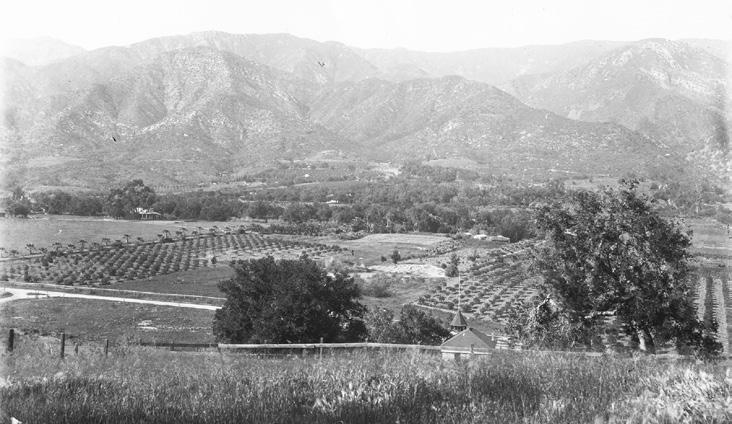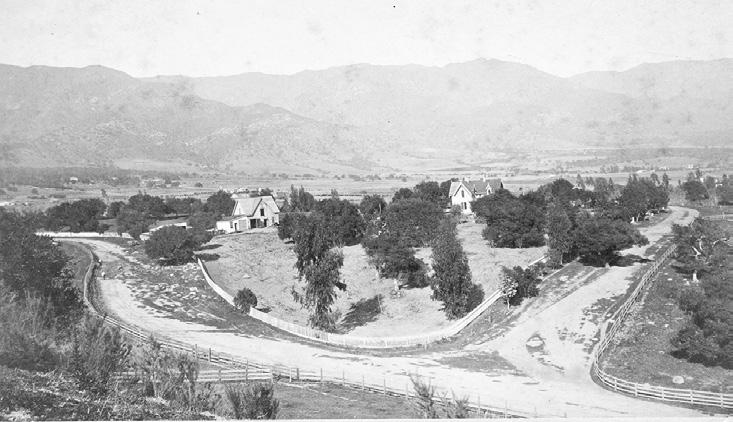
4 minute read
On the Record
Nicholas Schou is an award-winning investigative journalist and author of several books, including Orange Sunshine and Kill the
Messenger. If you have tips or stories about Montecito, please email him at newseditor@montecitojournal.net There Will Be Water
The 1890s Citrus Pivot (photo courtesy Santa Barbara Historical Museum)

is about the Wild West of California water politics, there’s a wonderful, if misattributed (to Mark Twain, no less) witticism that’s worth mentioning. “Whiskey is for drinking,” Twain’s supposed saying goes. “Water is for fighting over.”
Yet several times throughout the past water to this reliably bone-dry burgh. decimated. After the native Chumash century, the MWD has miraculously Previous articles in this series on people, Montecito’s original inhabimanaged to find new sources of water, Montecito’s complex water world tants were Spanish soldiers attached in each case, just in time to solve this have detailed the arguments both in to Santa Barbara’s Presidio and who age-old dilemma. In recent decades, favor and against MWD’s most recent were granted land in lieu of pay and although Montecito’s population has plan to solve our ongoing water crisis. a pension at the end of their service. stabilized, the town still ranks as one But to truly understand this latest Because the shallow wells of the day of the most lopsided water users in battle over our collective water future failed to deliver much water, they built California, with 85 percent of our requires a closer historical examinatheir small farms near the creeks that collective supply used for landscaption. Of course, given that this story swelled with winter rains every year. “There was enough water to support that small population,” said Beresford.
Drill Until Dust Montecito, circa 1880s (photo courtesy Santa Barbara Historical Museum) One hundred years ago, Montecito O n November 10, 2011, the ing as opposed to interior household was prime cattle grazing territory, a Montecito Water District needs. On June 25, Montecito’s water gentle sloping expanse of wide open (MWD), which was created board plans to solve this never-ending grasslands dotted with the occasional to provide residents with drinkable water crisis yet again. After a public oak, sycamore or bay tree, a far cry water, will celebrate its centennial hearing on that date, the water board from the lush paradise we know today. anniversary. It’s an auspicious occais expected to vote on whether to purA century earlier, trees were everysion, because Montecito doesn’t really chase a 50-year supply of desalinated where, but over the decades, early sethave any water, at least none you can water from Santa Barbara. The current tlers had cut much of the natural forfind under the soil. In fact, according debate over desalination has its roots est down for firewood. “They had to to countless studies – okay, only 18 in a recent extreme drought that proget their fuel from somewhere,” said studies – our underground aquifer duced a heated water board election local historian and Montecito Journal has always been leaky and unreliable. season in 2016 which unseated the contributor Hattie Beresford. And the 1,000 or more private wells water board’s previous leadership. In the 1870s, a town ordinance pro(nobody really knows the exact numHowever, that particular political bathibited the cutting down of coastal ber) that have so far been drilled into tle was just the latest skirmish in a oaks. Still, by the 1890s, Montecito’s the earth hasn’t helped matters. century-long war over how to deliver water-siphoning trees were all but
But as American farmers moved in the second half of the 1800s, both the creeks and the drinking wells went dry each summer. “When the wells dried up people closed their homes for the summer,” said Beresford. “Speculators began buying land to sell to Easterners looking for winter homes.”
Frustrated by the relative lack of Chef Dario Furlati water and the fact that there was no serving pizza & authentic Northern Italian Cuisine train to deliver their berries to market before they went bad, farmers morCarry Out & Curbside Pick Up phed Montecito’s agrarian landscape into citrus groves during the 1880s. 805-884-9419 ext 2 When that succeeded, water became cadariorestaurants.com scarce yet again, and for the first time, it became obvious that wells alone wouldn’t solve the problem. The next 10 MONTECITO JOURNAL “Accomplishments have no color.” – Leontyne Price
Montecito’s pre-MWD Cold Spring Tunnel (photo by Hattie Beresford)

solution: the construction of a series of horizontal water wells, essentially tunnels that were drilled at a slight downward angle from north to south which delivered water from the other side of the coastal mountain range to Santa Barbara and Montecito.
To pay for the construction of these concrete-lined tunnels, a dozen private water companies sold shares of the supply to local stakeholders, which was distributed via a network of redwood aqueducts. These aqueducts ran into a so-called division box that divvied up the water via a system of “miner’s inches,” which referred to the diameter of the hole that each customer had in the box, which, in turn, determined the volume of the water they received.
“That worked for a while,” Beresford continued. But as more people moved into the Santa Barbara area, the city purchased land in Montecito, and began diverting water from Cold Spring Canyon, which led to several lawsuits over water use, and ultimately, the creation of the MWD itself. By 1920 the time had come, as it so often would come again, for Montecito to find its own supply of new water.
Dam It All
After its official formation in 1921, the Montecito Water District immediately began construction of its










